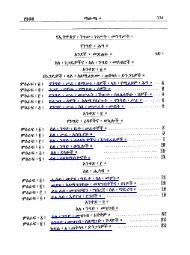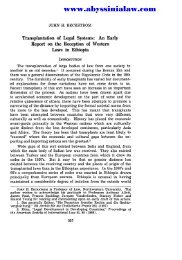You also want an ePaper? Increase the reach of your titles
YUMPU automatically turns print PDFs into web optimized ePapers that Google loves.
LEGAL SYSTEMS<br />
system and party presentation as representing a modern method of<br />
procedure, it was readily accepted by the Ethiopian judges, because it<br />
conformed to traditional practice. The new feature introduced was<br />
rules of procedure, which followed the common-law model. 2 7 6 In 1943,<br />
procedural rules were promulgated by the High Court, 2 7 1967] www.abyssinialaw.com<br />
and some<br />
additional rules were established at a later time. Those rules, though<br />
sketchy, governed procedure until the adoption of the Criminal Procedure<br />
Code and Civil Procedure Code. So, the judges operated under<br />
common-law procedure and to the extent they were familiar with<br />
procedure at all, it was with the common-law notion.<br />
Third, despite the adoption of civilian-based codes, litigation will<br />
have the same place in Ethiopia that it does in the common-law system.<br />
To the Ethiopian, a right necessarily means something that he can enforce<br />
in court, and he will be insistent on enforcing rights. Litigation<br />
will continue to be very frequent, and vindication of rights in court<br />
will be very important to the people. The hope was that detailed<br />
procedural rules, if properly applied, could significantly expedite the<br />
conduct of litigation, and it was necessary to have a process by which<br />
each phase of the litigation would be controlled.<br />
Finally, the judiciary did not enjoy such confidence or have such<br />
experience that it seemed wise to entrust them with wide discretion<br />
in the conduct of litigation. By demanding adherence to the rules of<br />
procedure, higher courts could insure that a fair trial was had in the<br />
lower courts. Arbitrary action, particularly that delaying the case,<br />
would be inhibited by the presence of procedural rules. The civilian<br />
approach, giving wide discretion to the judge, assumes a professional<br />
career judiciary which was lacking in Ethiopia. It was considered<br />
necessary to tell the judges what to do at each stage of the litigation<br />
2 7 8<br />
and to oversee their actions.<br />
Therefore, just as it was sound for Ethiopia to adopt codes on the<br />
continental model, it was sound to adopt the common-law approach<br />
to procedure. A mixed legal system in Ethiopia was a matter of necessity<br />
rather than, as elsewhere, a product of historical development.<br />
Originally, Professor Graven, the drafter of the Penal Code, had<br />
drafted a comprehensive judicial code following continental lines<br />
which covered evidence, civil procedure, and criminal procedure. The<br />
Codification Commission, however, decided that in Ethiopia the com-<br />
27 6<br />
Except for the institution of the jury, which was never introduced in<br />
Ethiopia.<br />
277 Under the AD1USSTRATON OF JusricE PRocLALAnoN oF 1942 art. 20, the<br />
Supreme Imperial Court and the High Court were authorized to promulgate rules<br />
with the approval of the Minister of Justice. The rules promulgated by the High<br />
Court were to be employed by the lower courts as well.<br />
278 See Graven, supra note 274, at 74.





